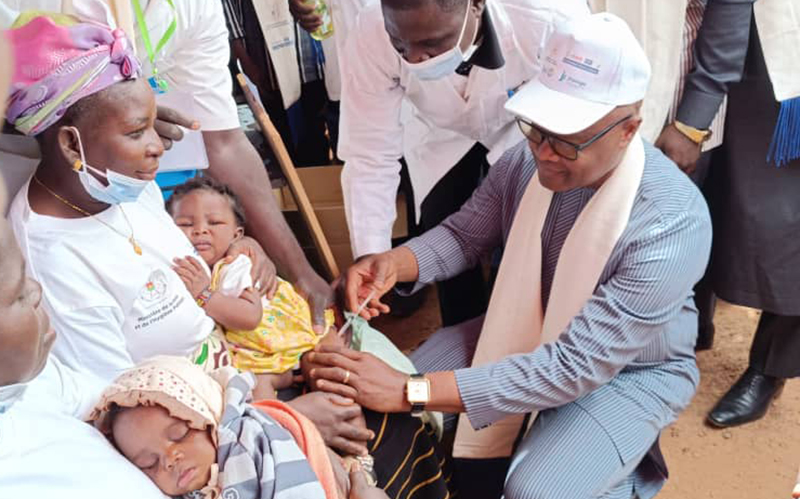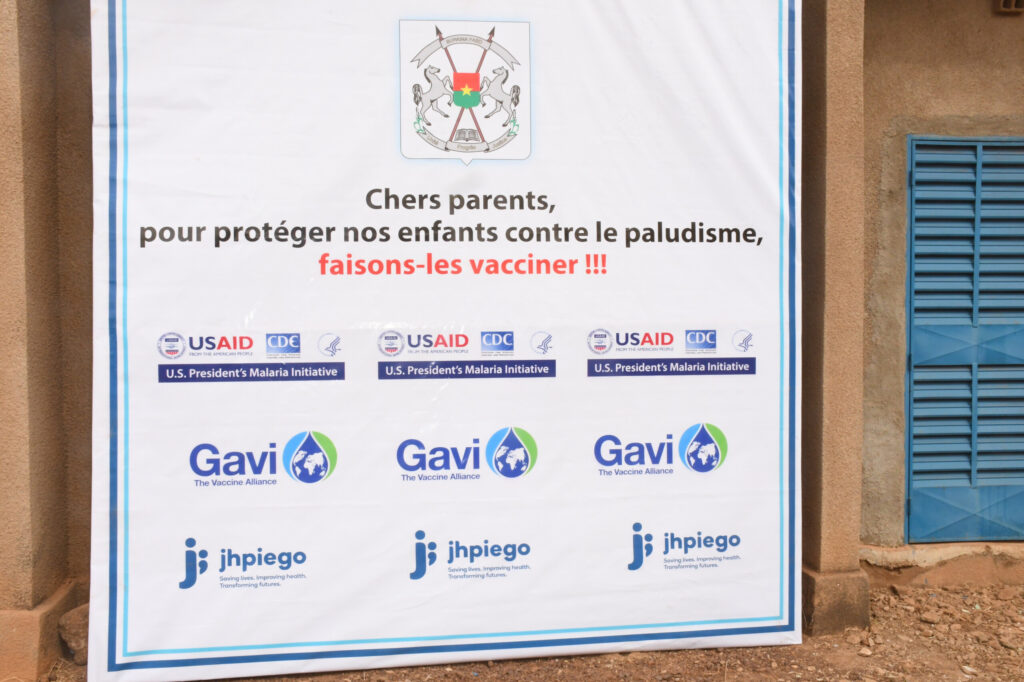As the eagerly awaited malaria vaccine moves from trial to rollout, Jhpiego is using its 20 years of experience in malaria prevention and treatment—from promoting insecticide-treated bed nets (ITNs), to supporting seasonal malaria chemoprevention and intermittent preventive treatment of malaria in pregnancy (IPTp), to providing training to health care workers to test for and treat malaria—to support the governments of Burkina Faso, Liberia, and soon, Côte d’Ivoire, in introducing the vaccine. Jhpiego editor Joan Taylor spoke with Dr. Christopher Morgan, Jhpiego’s technical director for immunization, about the potential impact of the vaccine in saving lives and improving health of the people we serve. Dr. Morgan is a pediatrician, public health physician and implementation research expert with more than 30 years of experience in immunization and related health areas and a member of the World Health Organization (WHO) Strategic Advisory Group of Expert’s COVID-19 Vaccines Working Group.
What is the outlook for vaccination against malaria in 2024?
In some ways, 2024 will be the most exciting year for vaccinating against malaria as up to 20 countries start to introduce the vaccine as part of their routine immunization schedule. We’ve been waiting for this since about 2016 when WHO said yes, this vaccine is good for use under demonstration conditions. With over 5 billion doses of RTS,S followed closely without raising safety concerns, earlier demonstrations have shown the vaccine to be safe and effective, so now it’s ready for scale-up.
The other thing that makes 2024 an exciting year is that we expect the second vaccine, the R21/Matrix M, which is produced by the Serum Institute of India, to be qualified, so that perhaps by the end of this year or early next year, it can be added.
In terms of efficacy, there’s been a 30% reduction in severe malaria needing hospital care, and a 9% reduction in deaths from any cause. Children who die from malaria are often vulnerable because they have malnutrition or because they have malaria plus pneumonia or some other infection at the same time.

Outside of supply, what is the biggest barrier to ensuring that all children who need the vaccine get the full course?
More than 28 countries have already expressed interest to Gavi in offering the vaccine, and have the policies in place to permit use of the vaccine and access. The remaining countries will have to put in place the policy or regulatory environment to permit use of the vaccine and access. Another hurdle is the standard barrier faced by all immunization programs in the low-income settings where malaria is a problem—reaching all families, because the families with children who are most vulnerable are also the families who struggle the most to access any sort of preventative primary health care.
There’s another barrier specific to the malaria vaccine, which is that it requires four doses, and the third and the fourth doses are needed late in the first year of life and then sometime in the second year of life, ages that fall outside the standard age bracket for all other childhood vaccines. Encouraging families to come for these extra visits will be critical, as well as extra outreach to get those third and fourth doses to children.
How can the malaria vaccine be integrated with other malaria interventions or health services?
The malaria vaccine does not replace all other malaria control interventions, such as ITNs, spraying to reduce mosquito populations, or IPTp. Rather, it’s another tool in the toolkit. In Burkina Faso, part of the Ministry of Health’s communications efforts that Jhpiego supports is reinforcing for nurses and families that the vaccine doesn’t mean you should stop all other malaria protective interventions, particularly sleeping under an ITN.
Another integration opportunity is around the fourth dose, which is given in the second year of life. The 15- to 24-month age bracket is a critical time in a child’s growth and development. It’s the last chance you have to prevent a child who is chronically malnourished from becoming stunted and having permanent effects of malnutrition. It’s also a time where if you can intervene in a child’s development, you can stimulate their psychosocial development as well. We are actively working with countries and Ministries of Health to identify opportunities to use that visit between ages 15 and 24 months to not just give the vaccine, but also check on the child’s growth and development and see if there are opportunities to improve.
This is an opportunity to extend our mutual experience in ensuring reliable supply of preventive therapeutic medicines to reliable supply of vaccines. Working in partnership with national malaria control and immunization programs, we can use our experience in identifying the populations that are most at risk—micro planning in immunization jargon—and how they can be reached to the malaria vaccine rollout.
How does the malaria vaccine fit into Jhpiego’s strategic priorities for immunization?
Jhpiego has four strategic priorities. The first is life course vaccination, which refers to vaccinating beyond the first year of life. As I’ve said, with the malaria vaccine, there’s a fourth dose in the second year of life. The second strategic priority is around integrated service delivery. And again, particularly in the second year of life, there’s the chance to integrate the vaccine with growth and nutrition. For all doses of the malaria vaccine, there’s a chance to integrate and at the same time strengthen broader malaria control interventions. It taps into what Jhpiego is doing in our malaria support to Ministries of Health and other aspects of maternal and child health. Our third strategic priority for immunization is around equity—making sure that we’re supporting ministry efforts to improve not just vaccine coverage in general, but also equitable coverage. The malaria vaccine is a good example of a resource going to areas of greatest need.
Our fourth strategic priority is around innovations. Any time you introduce an innovation, whether it’s a new vaccine, a new device, or a new way of running a program, you have a chance to strengthen the health system overall—the broader public health policy, for example, or the human resources needed for the new vaccine. – If an information system for a new vaccine needs to change, the whole of the health information system should benefit or be improved through that change. That’s the consideration. And if we have to improve the logistics and supplies for the new vaccine, how can we make sure it’s done in a way that strengthens the whole logistic and supply system?

Is there anything else unique to this vaccine?
There’s a whole other story about vaccines as a global good, and the interaction of Gavi, UNICEF and WHO together with pharmaceutical companies to get innovative products to the countries that need it but can’t afford it much more quickly than used to be the case. Before Gavi, poorer countries were waiting 10 to 20 years longer than richer countries to get new, effective vaccines into their systems. With Gavi in the mix and being clever about market shaping and pricing—buying in bulk and giving manufacturers certainty about future purchases and of the high volume of purchase—we can get these new vaccines to countries much quicker. Without Gavi and UNICEF working together, this would have been a vaccine for travelers for the next 20 years before eventually poorer countries would have been able to introduce it.
Dr. Christopher Morgan is Jhpiego’s Technical Director for Immunization.
Joan Caroline Taylor is an Editor II in Jhpiego’s Baltimore office.



